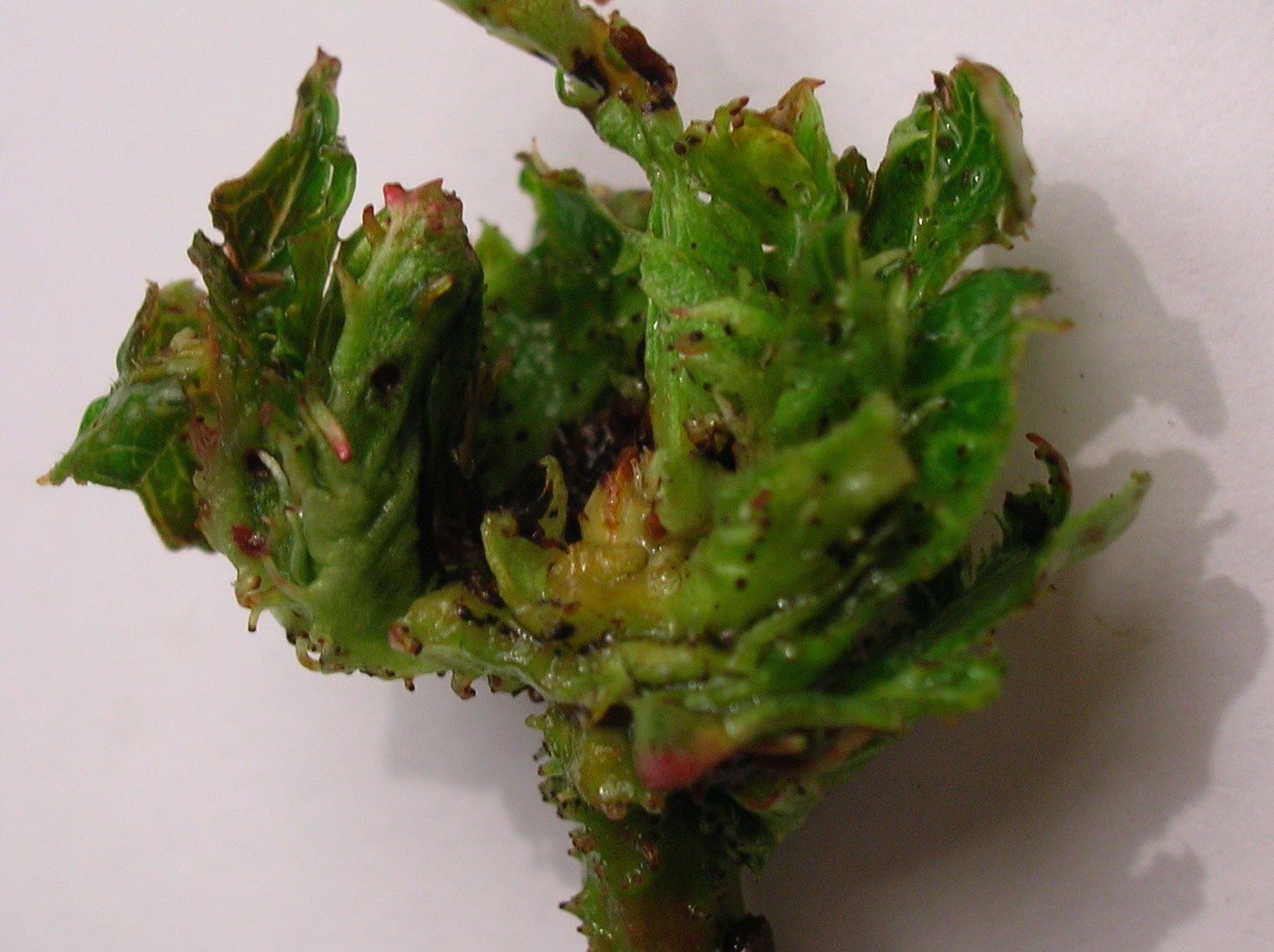Dasineura crataegi on:
[Wikipedia]
[Google]
[Amazon]
''Dasineura crataegi'', the hawthorn button-top gall-midge, is a
 The midge induces stunted and distorted rosettesHancy, Page 88 in the host by inhibiting the elongation of the shoot; the rosette is formed from many (8 to 40 or more) slightly thickened and deformed leaves with reduced petioles. Many of the leaves have small green or red ligulate excrescences or projections. The midge larvae are of an orange-red colour.Redfern, Page 315
The gall is occasionally found on isolated plants, but infestation is more commonly in hedges, with the new growth resulting from hedge cutting being the site of high density populations. The rosettes stand out prominently against the sky. Old galls persist and new shoots grow from unaffected buds lying well behind the terminal bud.
The midge induces stunted and distorted rosettesHancy, Page 88 in the host by inhibiting the elongation of the shoot; the rosette is formed from many (8 to 40 or more) slightly thickened and deformed leaves with reduced petioles. Many of the leaves have small green or red ligulate excrescences or projections. The midge larvae are of an orange-red colour.Redfern, Page 315
The gall is occasionally found on isolated plants, but infestation is more commonly in hedges, with the new growth resulting from hedge cutting being the site of high density populations. The rosettes stand out prominently against the sky. Old galls persist and new shoots grow from unaffected buds lying well behind the terminal bud.
 Adults emerge from pupae in the ground beneath the shrub and the terminal bud infestations start in March or April; the fully grown larvae fall to the ground in September or October to undergo pupation after feeding and sheltering within the leaf rosette for some time.
Adults emerge from pupae in the ground beneath the shrub and the terminal bud infestations start in March or April; the fully grown larvae fall to the ground in September or October to undergo pupation after feeding and sheltering within the leaf rosette for some time.
Images representing Cecidomyiidae
at
Google Images. Accessed : 2010-08-26
Taxonomy
{{Taxonbar, from=Q5226779 Cecidomyiinae Gall-inducing insects Insects described in 1853 Nematoceran flies of Europe Taxa named by Johannes Winnertz
diptera
Flies are insects of the order Diptera, the name being derived from the Greek δι- ''di-'' "two", and πτερόν ''pteron'' "wing". Insects of this order use only a single pair of wings to fly, the hindwings having evolved into advanced ...
n gall-midge. It causes the hawthorn button-top gall
Galls (from the Latin , 'oak-apple') or ''cecidia'' (from the Greek , anything gushing out) are a kind of swelling growth on the external tissues of plants, fungi, or animals. Plant galls are abnormal outgrowths of plant tissues, similar to be ...
, which develops in the terminal shoots of common hawthorn, ''Crataegus monogyna
''Crataegus monogyna'', known as common hawthorn, one-seed hawthorn, or single-seeded hawthorn, is a species of flowering plant in the rose family Rosaceae. It is native to Europe, northwestern Africa, and West Asia, but has been introduced in ...
'' Jacq., Midland hawthorn '' C laevigata'' (Poir.) DC and their hybrid, '' C × media'' Bechst.Stubbs, Page 23Redfern, Page 315 Synonyms are ''Perrisia crataegi'' and ''Cecidomyia crataegi'' (Winnertz, 1853).Darlington, Page 137
Appearance of the gall
Life-cycle
Distribution and control
The hawthorn button-top gall midge shows a scattered distribution throughoutEngland
England is a country that is part of the United Kingdom. It shares land borders with Wales to its west and Scotland to its north. The Irish Sea lies northwest and the Celtic Sea to the southwest. It is separated from continental Europe b ...
, however it is an under recorded species. The gall can be controlled by spraying with insecticide at the larval stage.
Parasitoids
''Aprostocetus
''Aprostocetus'' is a genus of hymenopteran insects of the family Eulophidae. The genus was erected by John O. Westwood in 1833. This very large group (about 800 described species) of parasitoid wasps has a global distribution.
Species
Widespr ...
lysippe'' is a hymenopteran insect of the family Eulophidae and a parasitoid of ''D. crataegi''.
See also
* '' Dasineura urticae''References
;Notes ;Sources * Darlington, Arnold (1968). ''The Pocket Encyclopaedia of Plant Galls in colour''. Pub. Blandford Press. Dorset. * Hancy, Rex (2000). ''The Study of Plant Galls in Norfolk.'' The Norfolk and Norwich Naturalist's Society. * Redfern, Margaret & Shirley, Peter (2002). ''British Plant Galls. Identification of galls on plants & fungi.'' AIDGAP. Shrewsbury : Field Studies Council. . * Stubbs, F. B. Edit. (1986) ''Provisional Keys to British Plant Galls''. Pub. Brit Plant Gall Soc. .External links
Images representing Cecidomyiidae
at
BOLD
In typography, emphasis is the strengthening of words in a text with a font in a different style from the rest of the text, to highlight them. It is the equivalent of prosody stress in speech.
Methods and use
The most common methods in W ...
Google Images. Accessed : 2010-08-26
Taxonomy
{{Taxonbar, from=Q5226779 Cecidomyiinae Gall-inducing insects Insects described in 1853 Nematoceran flies of Europe Taxa named by Johannes Winnertz